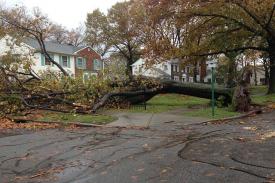
Sandy’s power is extending beyond the immediate time and place her winds blew and waters surged as businesses see delays hindering their ability to get merchandise into stores in time for the holiday shopping season.
The superstorm not only closed down shipping terminals and covered warehouses with floor to ceiling water. Deliveries were also hindered by fallen power lines, blocked and closed roads, and severe gasoline shortages in New Jersey and New York.
At any other time of year this would be seen as a serious hinderance to business, but now, just as retailers usually begin to prepare for the frenetic shopping of the Christmas holiday season such a backup or cancellation of orders can spell complete disaster. For many merchants the holidays are when the bulk of their business is contracted.
“Things are slowing down,” said Chris Merritt, vice president for retail supply chain solutions at the trucking company Ryder. “This whole part of the supply chain is clogged up.”
Several examples include:
• FedEx has rented fuel tankers to insure that its delivery trucks have a steady supply of fuel in the face of commercial stations running dry.
• Ryder has been looking for trucks to rent to add capacity.
• The major railroad company CSX has been advising their customers to expect delays at least 72 hours long on their shipments.
• Retailers such as Amazon and Diane von Furstenberg informed customers to expect shipping delays.
Economic analysts are predicting that the storm will reduce economic growth by as much as a half of a percentage point in the last quarter of 2012. This is a large decrease considering the entire economic growth for all of 2012 was expected to be only about 1-2 percent.
Direct losses from Sandy are going to be much less than the losses caused by Hurricane Katrina in 2005, but the impact of Sandy may well be greater in its aftermath due to the dense population in the Northeastern states where Sandy let lose her destructive forces.
The Northeastern US is responsible for about $3 trillion in output, which is about 20 percent of the nation’s total gross domestic product.
“Part of what was lost will be delayed, but part is lost forever,” said Gregory Daco a senior economist with IHS Global Insight.


